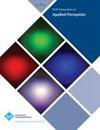眼间对比差异对增强现实图像外观的影响
IF 2.1
4区 计算机科学
Q3 COMPUTER SCIENCE, SOFTWARE ENGINEERING
引用次数: 0
摘要
增强现实(AR)设备寻求创造引人注目的视觉体验,将虚拟图像与自然世界融合在一起。这些设备通常依赖于可佩戴的近眼显示系统,该系统可以将数字图像分别光学地覆盖在用户的左眼和右眼上。理想情况下,两只眼睛应该显示具有最小辐射差异的图像(例如,两只眼睛的整体亮度、对比度和颜色相同),但在对重量和尺寸有严格要求的可穿戴系统中,实现这种双眼平等可能是一项挑战。基础视觉研究表明,眼睛之间存在辐射差异的图像可以引发一系列潜在的有害感知效应,但尚不清楚这些发现是否以及如何应用于现代AR设备的体验。在这项工作中,我们首先开发了一种测试范式,用于同时评估视觉外观的多个方面,并描述了当参与者观看具有眼间对比度差异的刺激时的五个关键感知因素。在第二个实验中,我们使用传统的台式LCD监视器模拟光学透视AR图像,并使用相同的范式来评估当两只眼睛之间的AR显示亮度不同时的多方面感知影响。我们还包括单目AR系统(即只有一只眼睛看到显示图像的系统)的模拟。我们的研究结果表明,在双目AR系统中,眼间对比度差异可能会导致几种潜在的有害感知效应,如双眼光泽、竞争和虚假深度差异。此外,单眼AR显示器往往比双眼中具有大对比度差异的双眼显示器具有更多的伪影。更好地理解这些感知现象的范围和可能性有助于为支持AR中高质量用户体验的设计选择提供信息。本文章由计算机程序翻译,如有差异,请以英文原文为准。
The effect of interocular contrast differences on the appearance of augmented reality imagery
Augmented reality (AR) devices seek to create compelling visual experiences that merge virtual imagery with the natural world. These devices often rely on wearable near-eye display systems that can optically overlay digital images to the left and right eyes of the user separately. Ideally, the two eyes should be shown images with minimal radiometric differences (e.g., the same overall luminance, contrast, and color in both eyes), but achieving this binocular equality can be challenging in wearable systems with stringent demands on weight and size. Basic vision research has shown that a spectrum of potentially detrimental perceptual effects can be elicited by imagery with radiometric differences between the eyes, but it is not clear whether and how these findings apply to the experience of modern AR devices. In this work, we first develop a testing paradigm for assessing multiple aspects of visual appearance at once, and characterize five key perceptual factors when participants viewed stimuli with interocular contrast differences. In a second experiment, we simulate optical see-through AR imagery using conventional desktop LCD monitors and use the same paradigm to evaluate the multifaceted perceptual implications when the AR display luminance differs between the two eyes. We also include simulations of monocular AR systems (i.e., systems in which only one eye sees the displayed image). Our results suggest that interocular contrast differences can drive several potentially detrimental perceptual effects in binocular AR systems, such as binocular luster, rivalry, and spurious depth differences. In addition, monocular AR displays tend to have more artifacts than binocular displays with a large contrast difference in the two eyes. A better understanding of the range and likelihood of these perceptual phenomena can help inform design choices that support a high-quality user experience in AR.
求助全文
通过发布文献求助,成功后即可免费获取论文全文。
去求助
来源期刊

ACM Transactions on Applied Perception
工程技术-计算机:软件工程
CiteScore
3.70
自引率
0.00%
发文量
22
审稿时长
12 months
期刊介绍:
ACM Transactions on Applied Perception (TAP) aims to strengthen the synergy between computer science and psychology/perception by publishing top quality papers that help to unify research in these fields.
The journal publishes inter-disciplinary research of significant and lasting value in any topic area that spans both Computer Science and Perceptual Psychology. All papers must incorporate both perceptual and computer science components.
 求助内容:
求助内容: 应助结果提醒方式:
应助结果提醒方式:


